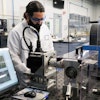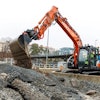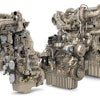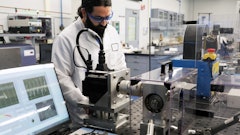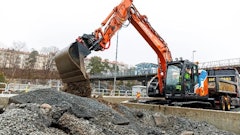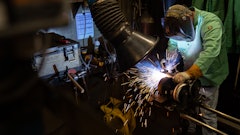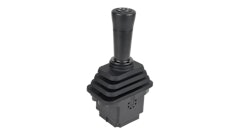The "elevator pitch" for Project Zeus should get people wanting more: An advanced propulsion system, it delivers a high level of safety, 30% better fuel economy, unsurpassed handling at high and low speeds, unparalleled systems integration and increased power density. Prodded for further details, Zeus sounds even better. However, you should know that the industry this CAN-based system is making a splash in is the recreational marine market, specifically high-dollar yachts. The technology that brought Zeus to life can be quickly applied to land-based mobile equipment where it will make work easier for the product development team, as well as the machine's operator.
The integration of digital information and mechatronic controls is giving on- and off-highway equipment a range of new capabilities. Already integrated into machines in a number of different industries, CAN has yet to meet its horizon. hile product development teams and end-users become more comfortable with implementing the protocol system on their equipment, component suppliers continue to advance the technology.
With four wires - input, output, power, and ground - making up its central wiring harness, the Controller Area Network (CAN) bus (Binary Unit System) system is an improvement over traditional wire-heavy designs. Going a step further, wireless CAN systems are now possible, enabling communication between multiple points on the machine as well as to implements or a technician's computer.
Meanwhile, suppliers work toward offering the hardware and software solutions required to supply entire systems. In a CAN bus layout, controllers manage specific areas while talking to each other. Writing the software that enabled that communication was a time-consuming, complex process. Creating that code is now easier.
Water wings
Developed by Brunswick Corp. divisions Mercury Marine, Cummins MerCruiser Diesel (a joint venture between Cummins and Mercury Marine) and MotoTron, Project Zeus brings technology that is common in planes and automobiles to yachts.
"The tremendous range of technical expertise at Brunswick allows a seamless approach to propulsion technology, marine electronics and on-board information management," says Dusty McCoy, chairman and CEO, Brunswick.
MotoTron's contribution will work in on- and off-highway mobile equipment. MotoTron itself was born in the marine industry. In the early 1990s boat manufacturers faced emissions regulations that would require advanced electronics systems. To gain the expertise, Fond du Lac, WI-based Mercury Marine recruited engineers from the car industry.
After placing several successful marine projects in their portfolio, the Mercury Marine group saw an opportunity to work with companies beyond Brunswick. With management's blessing, MotoTron was founded in 2000 as a separate entity to enter the on- and off-highway markets. Today it works closely with sister companies like Mercury Marine and the Brunswick Boat Group (brands such as Sea Ray), while also working with land-based applications. It is currently working closely with Parker-Hannifin on its RunWise hydraulic hybrid truck.
Headquartered just north of Fond du Lac in Oshkosh, MotoTron has 100 employees in Ann Arbor, MI; Columbus, IN; Ft. Collins, CO; Oshkosh, WI, and a network of supply partners.
"As the group worked on Brunswick's proprietary CAN network (marketed as SmartCraft), they knew the investment required to be at the top of the game in mechatronic system integration was very high," says Rich Swortzel, director of business development, MotoTron, Ann Arbor. "They knew they had to share that investment."
That's the sales pitch for MotoTron beyond Brunswick: Niche manufacturers in the off-highway industry must focus on their strengths. The technology required to meet electronic challenges and stay abreast of updates represents a tremendous investment - one that usually does not appeal to stockholders. Outsourcing that development to a specialist can make financial and practical sense.
As for MotoTron's yacht-programming expertise, Swortzel says, "Look at a boat. If you take away the water, put on a chassis and four wheels you've got a big delivery truck. Trucks and boats are both safety critical systems. We expect failures and design a system that works with them."
The difference is if an automobile or truck suffers an electrical fault, it can coast to the side of the road. When a boat malfunctions, its owners could be stranded dozens of miles offshore. Electronic engineers working on cars are concerned with system reliability in high volumes. MotoTron has focused on safety. "Everything in marine is drive-by-wire, so we already have the implementation for fault tolerant CAN." In mobile equipment, safety and reliability are key, whether resurfacing a highway or opening a mine tunnel.
Look, no wires!
Enrange LLC specializes in remote control systems for mobile and industrial equipment. The company got its start developing electronic controls for mining equipment.
"Rock mines are a tough environment," says Wayne Koenig, sales manager, Enrange, Canonsburg, PA. "Having a durable and reliable product is key." While that led to more durable products from Enrange, it was also a good lesson of where to run wires and where not to, and the increasing need for more wireless controls. There are many pinch points on mobile equipment.
Over the past three years Enrange's work with mobile electrohydraulic systems has been increasing, involving a variety of CAN protocols, including J1939 and CANopen. "What makes us a little different, says Chris Dulin, owner and engineering manager, Enrange, "is we are comfortable jumping on the CAN bus in mobile machinery and talking to other controllers."
Recently, Enrange built on its expertise with CAN and removed the twisted pair of wires. With its new WIC 2400 2.4Ghz wireless data link "you are able to cut the CAN line," says Koenig.
Multiple units can be installed on the same machine. For one customer, Enrange supplied a server and three clients. One WIC 2400 transceiver communicated with three different areas of the machine, unencumbered by wires.
Ideal for quick-change motor-driven attachments on an excavator or tree harvester, the WIC 2400 was developed as a project for a customer. "We do a lot of custom work," says Koenig. "We have added little tweaks or major changes to many standard products to meet customer requirements. The WIC 2400 is available in standard or custom versions.
The WIC-2400, as well as other Enrange products, are manufactured in southwestern Pennsylvania. "We like building our products from the circuit board up, so we have full control of deliveries, service and support," says Koenig.
System provider
One of the limiters for CAN adoption has been the cost of the systems, but the price has been going down, says Jon Williams, manager of sales and application engineering, STW Technic, Norcross, GA. From its offices near Atlanta and in Germany, STW Technic offers the entire CAN bus system, including displays, joy sticks, controllers and pressure sensors.
"Europe does a lot with protocol systems," says Williams. "We are maybe five years behind Europe, which has more invested in automated technology. U.S.-based OEMs need to be able to provide CAN systems to compete globally."
Industries that adopted the technology first were ones selling high-dollar machines. "We are a ways from seeing a residential lawn mower equipped with CAN bus," says Williams. "That being said, the cost is coming down quite a bit. I see the rental market, like skid steers, taking advantage of wireless applications." Wireless capabilities would allow the rental house to quickly locate a machine.
Among STW's product offering is the ESX-C2C controller, available with Bluetooth and GPS capabilities and an optional GSM/GPRS modem to connect to a cellular network. With ESX-C2C installed on a vehicle, the owner merely has to dial up the machine. This permits software revisions or monitoring the machine's health.
"All the information is on the CAN bus network in the vehicle," says Williams. "You simply dial up via a cellular network and grab the code." In areas with no coverage, the Bluetooth module communicates with the vehicle when it returns to the shop.
"I see the movement to an open protocol like J1939 and wireless as the big trends," says Williams. "Wireless really opens up the world."
J1939 and CANopen
"We are in the middle of a growth spurt with CAN adoption. Some of our customers tell us they need CAN in their machines but they don't know much about it," says Amanda Wilkins, marketing manager, Axiomatic Technologies Corp., Mississauga, ON, Canada. "They see the need as the industry is moving in that direction."
Axiomatic has introduced a range of CAN-capable components with an eye toward offering a complete subsystem solution.
"Most of our new products in the last two years have CAN bus on them," says Wilkins. "If we are making a generic product we offer it in both. The only difference is the software embedded in the processor."
SAE J1939 communication standard has been the most common in North America. For the worldwide customers of companies like STW Technic and Axiomatic (the latter has offices in North America and Finland), introducing a product for a CAN bus network means offering it in both J1939 and CANopen.
Axiomatic offers standard hardware with custom software. "I don't believe CAN could be a generic off-the-shelf system, because engineers want to look at specific messages and do some fine tuning." Most OEMs provide Axiomatic engineers with a list of what they are monitoring. Some OEMs are quite sophisticated, while others are not. OEM engineers usually have something specific within in the machine's systems they are looking for.
To take some of the mystery out of a CAN system, the Axiomatic Electronic Assistant software tool is available. Sold as a kit, it runs on a PC to configure and monitor Axiomatic's modules.
Cylinder sensing
Sensors are required if the CAN bus network is to monitor various systems throughout the vehicle. For that requirement, MTS Systems Corp., Sensors Div., offers an MH sensor with a CAN bus interface. The compact sensor is designed for use in welded and tie-rod cylinders, or any space-limited cylinder applications.
The MH sensor works with CAN J1939 and CANopen, measuring displacement and speed variables. The sensor is highly reliable once installed inside a hydraulic cylinder.
"We have seen an increase in requests for a CAN bus type of architecture," says Brian Cox, technical marketing manager for mobile hydraulics, MTS, Cary, NC. This product came about as a direct request from a customer.
The MH sensor consists of a sensor head with rugged housing and built-in electronics, a pressure-proof sensor pipe that protects the internal sensing element, and a position magnet. Along with high shock and vibration ratings, the sensor has 200V/m EMI protection. It is designed for 2 in. dia. cylinders or larger. MTS offers a standard sensor and customizes the protocol for the OEM.
"Once a customer installs an in-cylinder sensor they realize that with this measurement device many other features are possible." Steering systems have been the most popular application for the MH sensor. Monitoring functional motion such as bucket leveling is another application.
Whether an analog or digital sensor, the form and fit is exactly the same. The differences are internal to the sensor. This gives flexibility to the OEM, which may be using an analog sensor today but has plans to transition to a protocol system. The new sensor fits right in.
CAN make it easy
MotoTron's Rich Swortzel believes much more can be done with CAN systems. He has talked with distributors, component suppliers, and OEMs. He believes too many engineers are afraid of developing such a system.
The company's MotoHawk control software development program provides the ability to develop, test and validate control applications using Simulink/Stateflow models on production electronic control hardware. By utilizing model-based design and code generation, MotoHawk helps take the mystery out of designing a CAN system.
"MotoHawk gives the mechanical engineer who gets up to his elbow in oil the ability to build software," says Swortzel. "That is who should be doing software. They are most familiar with the machine."
MotoTron's experience with its own product can be the same for suppliers: "MotoTron had one guy building applications for our company, writing the specifications for CAN, and three guys writing the codes to support it. At many companies much of that engineering work is being sent overseas. With MotoHawk, MotoTron now has three engineers working with the customer building applications and one guy writing codes."
MotoHawk has users at OEMs and major suppliers. Distributors also work with MotoTron's tools, enabling them to offer a complete package to customers.
"This is about figuring out how to get the best low-cost resources in the door to do the work. Utilizing the engineer who knows how the machine works by giving him the ability to do code generation and software development makes a lot of sense," says Swortzel. "Mechatronics is here to stay. CAN enables a high level of productivity. If we are able to help companies with a proud history stay in business and compete internationally, I am excited. Mechatronics is a field we are passionate about."
